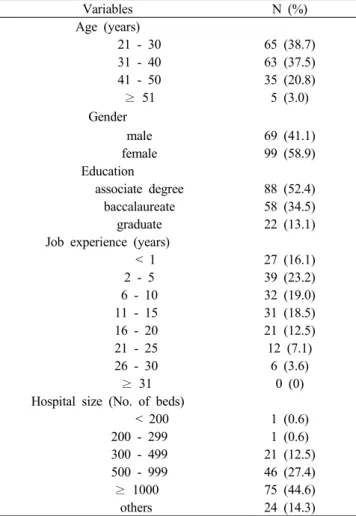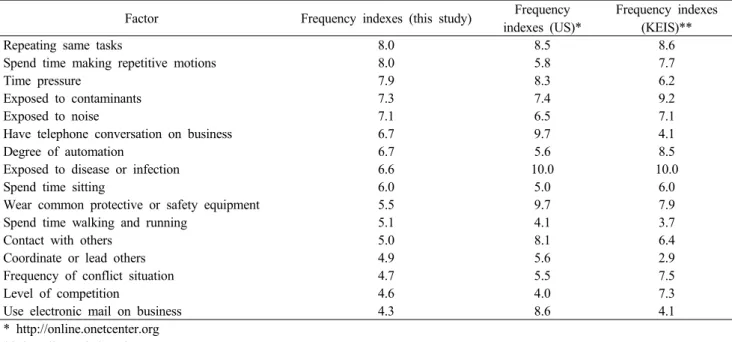Factors Affecting the Job Performance of Clinical Laboratory Scientists
Moon-Jung Shim
Department of Clinical Laboratory Science, Ansan College, Ansan 426-701, Korea
Clinical laboratory testing plays a crucial role in the detection, diagnosis, and treatment of disease.
Clinical laboratory scientists evaluate test results, develop and modify procedures, and establish and monitor programs, to ensure the accuracy of tests. It is clear that over the past decade the role of the clinical laboratory scientists has expanded and this process will be continued into the future. The purpose of this study is to clarify the factors influencing the job performance of clinical laboratory scientists and aim to provide the role and duties of clinical laboratory scientists. To examine the frequency of work context and the importance of task, the surveys were conducted on 168 clinical laboratory scientists. The questionnaire items were used 10 score by Likert scale. According to the results of this study, the important factor affecting the job performance was “Analyze laboratory findings to check the accuracy of the results”, and the next factors were “Establish and monitor quality assurance programs”, “Enter data from analyzer into computer”, “Calibrate and maintain equipment”. And the factors of “repeating same tasks” and “spend time making repetitive motions” were answered the highest. This study will provide strategies for improving work environment, developing education curriculum and method, and role of clinical laboratory scientists. We must continually upgrade our knowledge, and identify the new trends in technology and science and accept changes.
Received 6 OCT 2009/Accepted 18 NOV 2009 Key Words : Job performance, Clinical Laboratory Scientist, Task, Work context
I. Introduction
Laboratory Medicine has contributed for centuries to the diagnosis of human disease (Gornall, 1976). Clinical laboratory scientists perform complex chemical, hemat- ological, immunologic, microscopic, and bacteriological tests. They look for bacteria, parasites and other micro- organisms, also make cultures of body fluids and tissue
교신저자 : 심문정 (우) 425-701 안산시 상록구 일동 752번지 안산1대학 임상병리과
TEL : 031) 400-6938 E-Mail : mjshim@ansan.ac.kr
samples, to determine, to presence of bacteria, and analyze the chemical content of fluids, and type and cross match blood for transfusions, and test for drug levels in the blood that show how a patient is responding to treatment. They use microscopes, cell counters, and other sophisticated laboratory equipment. They also use automated equipment and computerized instruments which are capable of performing a number of tests simultaneously. After testing and examining a specimen, they analyze the results and relay to medical doctors.
The duties and responsibilities of clinical laboratory scientists and physicians are still evolving. Clinical laboratory scientists are responsible for the performance of
the majority of clinical laboratory tests that aid medical doctors in the diagnosis and monitoring of disease. Their role requires in-depth knowledge of subject together with scientific, technical and practical expertise (Manley, 2000).
Improvements in automation and computing technology have allowed significant gains in efficiency within the laboratory. Bar-coded specimen identification and primary sample handling have removed the need for sample transfer and virtually eliminated errors caused by transportation of specimens. The majority of results are transmitted through analyzer interfaces and electronic reporting systems, thus removing potential error due to transcription of data.
It is imperative that the clinical laboratory scientists maintain an up-to-date working knowledge of automated systems and information technology. This includes the principles behind automated specimen handling and electronic transfer of data.
It is clear that over the past decade the role of the clinical laboratory scientists has expanded and this process will be continued into the future. Clinical laboratory scientists will be expected to collaborate and consult more widely with other health care professionals from their organizations.
The object of this study is to clarify the factors influencing the job performance of clinical laboratory scientists and compare to other data. This study aims to provide the role and duties of clinical laboratory scientists.
II. Methods
168 clinical laboratory scientists completed a survey on the factors that influence job performance. The questionnaires were consisted of demographic information, core tasks, work context, and work activities. The data were collected in Sep. 2009, and the questionnaire items were used 10 score scale by Likert response scale. The
average performance score was compared to the answers from the Occupational Information network of US (http://online.onetcenter.org) and Korea Employment Information Service (http://www.keis.or.kr). All the collected data was analyzed by SPSS (for Windows, version 17.0) program.
III. Results
Of the 220 clinical laboratory scientists to whom the questionnaire was sent, 168 (76.4%) returned the questionnaire completed. 4 (1.8%) of them were invalid.
The characteristics of study participants were shown below (Table 1). Male was 69 (41.1%), and female was 99 (58.9%). According to the data, the largest group were the 30‘s age group and 2-5 years job experiences group and associate degree group.
The important factor affecting the job performance was
“Analyze laboratory findings to check the accuracy of the results”, whereas “Conduct automated analyzer” was the highest in US (Table 2). And the next factors were
“Establish and monitor quality assurance programs”,
“Enter data from analyzer into computer”, “Calibrate and maintain equipment”.
According to the frequency indexes of work context, the factors of “repeating same tasks” and “spend time making repetitive motions” in clinical laboratory were the highest (Table 3). Compared to US data and KEIS Korea data, the frequency index of “exposed to disease or infection” was the highest. It means that potential vocational infection is neglected than US. And it suggests that laboratory safety education is needed. Another important thing was that the clinical laboratory scientists got time pressure in the laboratory.
Variables N (%) Age (years)
21 - 30 65 (38.7)
31 - 40 63 (37.5)
41 - 50 35 (20.8)
≥ 51 5 (3.0) Gender
male 69 (41.1) female 99 (58.9)
Education
associate degree 88 (52.4) baccalaureate 58 (34.5)
graduate 22 (13.1)
Job experience (years)
< 1 27 (16.1) 2 - 5 39 (23.2)
6 - 10 32 (19.0)
11 - 15 31 (18.5)
16 - 20 21 (12.5)
21 - 25 12 (7.1) 26 - 30 6 (3.6)
≥ 31 0 (0) Hospital size (No. of beds)
< 200 1 (0.6)
200 - 299 1 (0.6)
300 - 499 21 (12.5)
500 - 999 46 (27.4)
≥ 1000 75 (44.6)
others 24 (14.3)
Table 1. Demographic data
IV. Discussion
Clinical laboratory testing plays a crucial role in the detection, diagnosis, and treatment of disease. Clinical laboratory scientists evaluate test results, develop and modify procedures, and establish and monitor programs, to ensure the accuracy of tests. Some scientists supervise clinical laboratory personnel.
With increasing automation and use of computer technology, the work of technologists has become less hands-on and more analytical. The complexity of tests performed, the level of judgement needed, and the amount of responsibility workers assume depend largely on the amount of education and experience they have
(Colliera et al, 2001).
In the past, clinical laboratory scientists have only been able to promote to senior positions and higher salaries by becoming more management oriented. Changes are now in progress that will allow staff to develop through their professional practice to the higher grades of advanced practitioner and be remunerated accordingly. In the future, it is likely that clinical laboratory scientists who practice at the highest levels and demonstrate that they are experts in their own field and professional leaders will progress to achieve the status of consultant clinical laboratory scientist.
The limit of this study was that our profession is extremely diverse, and it may be difficult to find many clinical laboratory scientists with the exactly same duties.
So this study analyzed only core of tasks.
According to this study, the factor of the frequency index of "exposed to disease or infection" was much different from other data. When proper methods of infection control and sterilization are followed, few hazards exist. Protective masks, gloves, and goggles are necessary to ensure the safety of laboratory personnel.
Thus clinical laboratory personnel should be trained to work with infectious specimen and change their mind.
Employers seek clinical laboratory personnel with good analytical judgement and the ability to work under pressure.
Clinical laboratory scientists in particular are expected to be good at problem solving. Close attention to detail is also essential for laboratory personnel because small differences or changes in test substances or numerical readouts can be crucial to diagnosis. Manual dexterity and normal color vision are highly desirable, and with the widespread use of automated laboratory equipment, computer skills are important. Clinical laboratory science program curricular must address the need for clinical laboratory scientists to read use these tasks. This study will provide strategies for improving work environment, developing education curriculum and method, and role of clinical laboratory scientists. And we must continually upgrade our knowledge, and identify the new trends in technology and science and accept changes.
Factor importance indexes (this study) importance indexes (US)*
Analyze laboratory findings to check the accuracy of the results 8.8 9.5
Establish and monitor quality assurance programs 8.7 9.0
Enter data from analyzer into computer 8.7 9.3
Calibrate and maintain equipment 8.7 9.0
Set up, clean and maintain lab. equipment 8.3 8.6
Conduct automated analyzer 8.0 9.6
Supervise, train lab personnel 7.9 7.7
Documenting/Recording information 7.8 8.4
Making decisions and solving problem 7.8 7.6
Communicating with supervisors, peers 7.8 7.5
Analyzing data or information 7.7 7.0
Interacting with computers 7.6 8.4
Organizing, planning work 7.6 7.6
Getting information 7.5 7.3
Coordinating the work and activity 7.4 4.7
Thinking creatively 7.3 3.6
Training and teaching others 7.1 5.2
Performing administrative activities 6.9 3.2
* http://online.onetcenter.org
Table 2. Importance indexes of work activities
Factor Frequency indexes (this study) Frequency
indexes (US)*
Frequency indexes (KEIS)**
Repeating same tasks 8.0 8.5 8.6
Spend time making repetitive motions 8.0 5.8 7.7
Time pressure 7.9 8.3 6.2
Exposed to contaminants 7.3 7.4 9.2
Exposed to noise 7.1 6.5 7.1
Have telephone conversation on business 6.7 9.7 4.1
Degree of automation 6.7 5.6 8.5
Exposed to disease or infection 6.6 10.0 10.0
Spend time sitting 6.0 5.0 6.0
Wear common protective or safety equipment 5.5 9.7 7.9
Spend time walking and running 5.1 4.1 3.7
Contact with others 5.0 8.1 6.4
Coordinate or lead others 4.9 5.6 2.9
Frequency of conflict situation 4.7 5.5 7.5
Level of competition 4.6 4.0 7.3
Use electronic mail on business 4.3 8.6 4.1
* http://online.onetcenter.org
** http://www.keis.or.kr
Table 3. Frequency indexes of work context
References
1. Colliera CP, Crowe AT, Stinson RA, Chu SY, Houlden RL. The continuing professional development of the Canadian Society of Clinical Chemists and the Canadian Academy of Clinical Biochemists. Clin Biochem. 34(2):91-96, 2001.
2. Gornall AG. Future education and training require
ments of clinical biochemists. Clin Biochem 9:56-61, 1976.
3. Manley K. Organisational culture and consultant nurse outcomes: Part 1. Organisational culture. Nurs Stand 14(36):34-38, 2000.
4. Manley K. Organisational culture and consultant nurse outcomes: Part 2. Nurse outcomes. Nurs Stand 14(37):
34-39, 2000.

